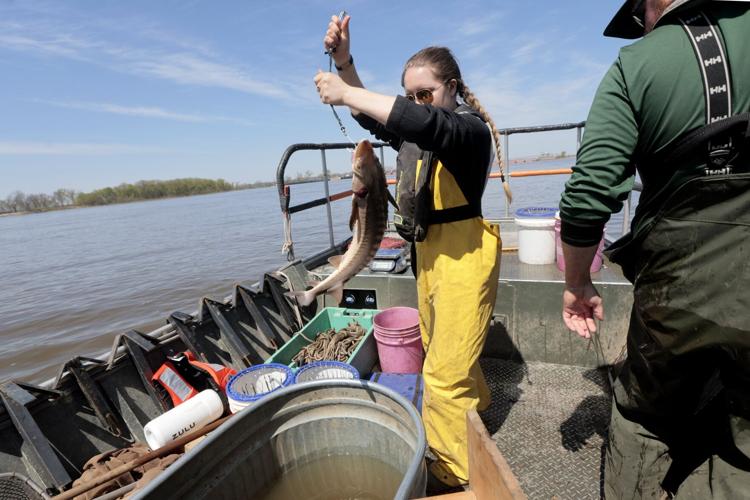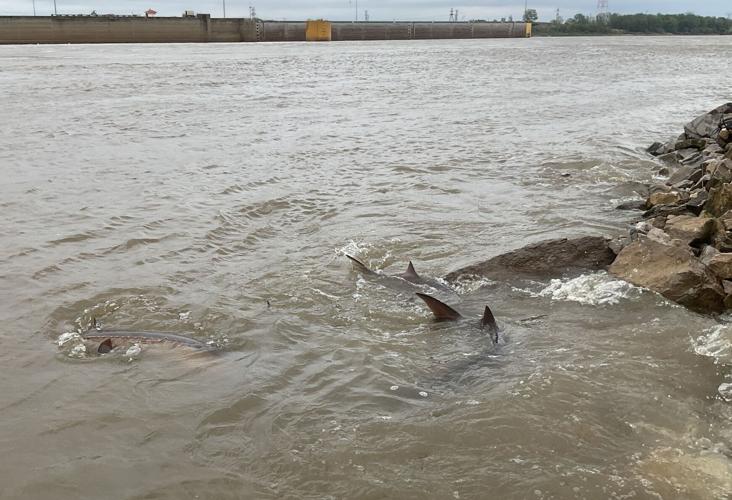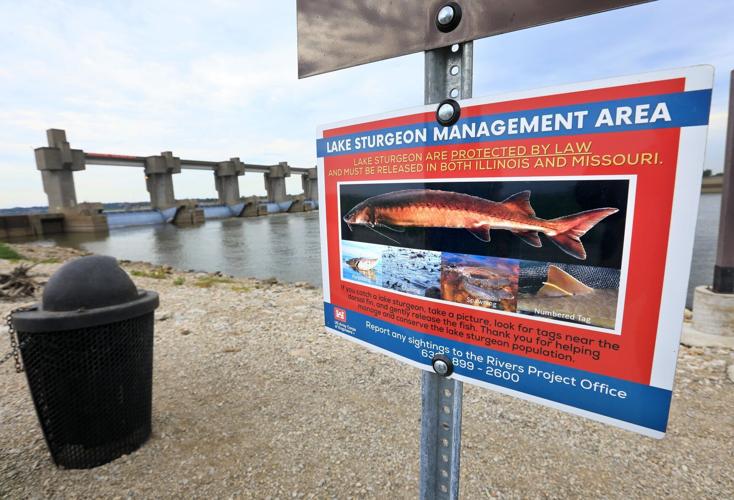WINFIELD — In a spot where a cliff plunges into the Mississippi River below Lock and Dam 25, state wildlife officials took one last stab in the search for their famously large and long-lived quarry: a lake sturgeon.
At that last stop in a day of April field work north of St. Louis, finally one of the rare fish with its distinctive, whisker-like barbels emerged from the murky water, hooked on a line. Scientists hauled it aboard the Thunderfish, their aluminum boat with a sturgeon painted on its side. They weighed and measured their catch, and passed a metal detector wand over it to check for identification tags.
After years of not seeing lake sturgeon spawning, or reproducing, in waters near St. Louis, state and federal wildlife officials have witnessed a run of success by the Melvin Price Locks and Dam, near Alton.
Now, scientists are looking for evidence the fish are spawning in other locations — like 50 miles north of St. Louis at Winfield and other dams along the Mississippi, and on the Osage, Gasconade and Salt rivers. Despite their name, lake sturgeon tend to be found in big rivers.
People are also reading…
- Goold's chat: Are Cardinals at a crossroads with catchers, trade options, and Nolan Gorman?
- Raised, glazed and amazed: St. Louis’ most essential doughnut shops
- 99.1 Joy FM wins auction for KDHX with $8.75 million bid, double an early offer
- Shouting matches, traffic cones, a fox costume: St. Charles convention parking erupts

Missouri Department of Conservation Fisheries Technician Rylee Carley transfers a subadult lake sturgeon into a holding tank on Wednesday, April 17, 2025, on the Mississippi River in Winfield. The fish was too small to receive a telemetry transmitter for their study.
The search is part of the decades-long push to help the species bounce back from the brink of elimination locally, after widespread habitat changes and overfishing. Sometimes the fish are poached for black-market caviar, despite harsh penalties in place for offenders. And researchers are concerned that Trump administration cuts to federal staffing and funding could threaten programs, like this, that benefit the fish population.
The scientists are trying to catch adult lake sturgeon and tag them with acoustic telemetry transmitter devices, about the size of a lipstick tube, that help track the fish as they move through rivers and swim past equipment that can pick up their signal — information that can help reveal where they congregate when it’s time to spawn.
Lake sturgeon can grow to become 8 feet long, weigh 300 pounds and reach 150 years old. And tagging the fish has revealed that they get around.
One lake sturgeon that was caught and tagged near Hannibal has gone on an astounding odyssey over recent years — earning the nickname “Scout” after voyaging southward in the Mississippi and wrapping slightly into the Ohio River, and repeatedly swimming the Missouri River between the St. Louis region and South Dakota, where a hydropower dam prevents any further progress to the northwest.
“Scout” isn’t the only lake sturgeon to cover nautical ground. Last year, Missouri Department of Conservation fisheries biologist Sarah Peper and colleagues caught one that had come at least 651 miles, with a tag from Wisconsin.
That same fish was recently captured again even farther away, between Columbia, Missouri, and Kansas City, by the confluence of the Grand and Missouri rivers, Peper said.
“There are some fish that are just intrepid — they’re travelers,” she said.
‘Needle-in-a-haystack’ moments
Despite measuring nearly 30 inches long, the lake sturgeon caught by the cliff near Winfield last month was too small for the lipstick-sized transmitter. Still, the “subadult” sturgeon received a smaller pit tag, like those put in pets, for identification in the future.
“We’re really looking for those adult fish so that we can track them and learn more about their spawning habitat,” Peper said. She has helped spearhead the work.

Gracie Phillips with the Army Corps of Engineers steadies a sub-adult lake sturgeon as Missouri Department of Conservation Fisheries Technician Christian Goodson scans the ancient fish for a tag on Wednesday, April 17, 2025, on the Mississippi River in Winfield. The fish was too small to receive a telemetry transmitter for their study.
Experts like Peper marvel at the incredibly adaptable “dinosaur fish” that have survived over the eons. Much more recently, however, they’ve faced peril alongside humans.
“We’ve managed to drive them to the brink of extinction in less than 100 years,” said Peper. While the population’s slow rebound has been aided by reintroduction efforts, she wonders about the future that the fish will grow to inherit in the Mississippi, including the subadult recently hoisted onto the Thunderfish.
“Let’s say he’s 15 years old,” she said. “What is this river gonna look like by the time he’s 100?”
The species’ longevity, though, requires patience for those trying to see the population rebound. The conservation department began stocking regional waterways with young lake sturgeon “fingerlings” in 1984, and it takes 15 to 20 years for female lake sturgeon to reach reproductive maturity, Peper said, and even longer for them to ramp up their egg production.
But they can keep spawning for a century or more, as illustrated by an estimated 125-year-old female — thought to be hatched when Grover Cleveland was president — that was laden with eggs when caught and released in Wisconsin, in 2012.

An endangered lake sturgeon egg, center, is seen on a rock, held next to dime for size comparison, near where the fish were seen spawning at Maple Island Access in West Alton the week of April 17, 2023.
The fish also must take a while to recharge after spawning, with three to five years between cycles. The sturgeon start to develop eggs a year or two before they spawn, Peper said. Finding black eggs in a female fish, extracted while they’re alive, signal that she will spawn that year.
Besides the broad timescales at play, very specific conditions are required for lake sturgeon to spawn.
For example, the water needs to be in a specific temperature range, between about 50 and 55 degrees, and the fish need a rocky, cobbly surface that their adhesive eggs will stick to. Additionally, the water must have a certain flow, to oxygenate the eggs.
On top of that, there are obstructions like locks and dams to contend with, which can block the movement of sturgeon along rivers.
“They sort of pile up below the dams,” said Peper.

A sign just below the Melvin Price Locks and Dam on the Mississippi River warns fishermen to release lake surgeon if they are caught, on Monday, Aug. 8, 2022. The rocky shore line below the dam is Missouri's only known breeding habitat for lake sturgeon. The area is the proposed site of a hydropower proposal that could affect the sturgeon laying eggs.
One goal of partnering agencies like the U.S. Army Corps of Engineers is to support suitable conditions for lake sturgeon to spawn in areas below dams, aided by federal grant funding through the Sustainable Rivers Program.
“For the Mississippi River, we’re focusing on the tailwaters of dams, because that’s where we can control the (water) flow,” said Peper. “We can at least make that area suitable for spawning by controlling the flow when they need it.”
There are other goals in mind, too. Near Melvin Price, MDC personnel had aimed to catch adult sturgeon to collect their eggs and milt, or sperm, for use in the state’s own fish hatchery facilities. Missouri’s longstanding arrangement of getting sturgeon from a Wisconsin hatchery recently ended.
And since spawning can usually only be seen with the naked human eye when it takes place in very shallow water, other tools besides the telemetry tags also reveal where the log-sized fish are gathering — like a high-resolution sonar that U.S. Geological Survey scientists have used to detect dozens of the fish congregated near Melvin Price.
Experts even enlist the help of volunteers and fishermen to keep an eye out for the activity, which is how it was first witnessed in 2015.
“There’s got to be more places out there,” said Peper. “It’s kind of a needle-in-a-haystack thing.”

Adult lake sturgeon spawn in April 2025 on the Missouri side of the Mississippi River, near the Melvin Price Locks and Dam across from Alton, Ill. The massive, regionally endangered fish have spawned in that spot for several years running, and experts are working to see if the behavior is catching on in other locations.













